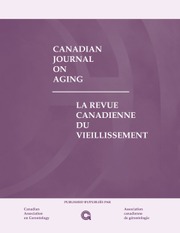-
- Get access
- Contains open access
- ISSN: 0714-9808 (Print), 1710-1107 (Online)
- Editor: Dr Veronique Boscart Canada
- Editorial board
Call for Nominations and Applications
The Canadian Journal on Aging / La Revue canadienne du vieillissement is seeking nominations or applications to fill several positions on the Editorial Board.
Appointments are normally for a four-year term. Nominations and applications are currently being accepted.
Click here for more information.
Open Access
The Canadian Journal on Aging/ La Revue canadienne du vieillissement (CJA/RCV) is committed to supporting fair access to scholarship. In line with the SSHRC open access policy, all CJA/RCV content from 2019 onwards will be available for free online subject to a 12-month embargo. This policy means that all articles will be made free to access, with no paywall, 12 months after they have been published in an issue on Cambridge Core. The journal’s other open access policies, including manuscript archiving via Green Open Access, remain unchanged.
September Article of the Month
Is There a Cohort Explanation for Declines in Elderly Migration?
Barry Edmonston, Sharon M. Lee and Zheng Wu
Abstract
Previous research documented a dramatic decline in the residential mobility of elderly Canadians (65 years and older) since 1961. We examine more recent data from the 2011 and 2016 censuses to update findings and extend previous research. We first found that elderly residential mobility has continued to decline. There were substantial declines of 20 per cent and more for all types of residential mobility. Second, descriptive analysis of changes over time in the proportion of the population that lives in a different province than their province of birth for 1871 to the present suggests that the 1906–1925 birth cohorts experienced migration rates that were slightly higher than comparable later cohorts. Third, multivariate analysis of 1971–2016 interprovincial migration data shows that the 1906–1925 birth cohort who entered early adult years during World War II had higher migration rates than earlier or later birth cohorts. The cohort explanation accounted for 10 per cent of the decrease in elderly migration between 1981 and 2016. A cohort explanation can therefore contribute to understanding decreased elderly migration, but many questions remain for future study.
Résumé
Des recherches antérieures ont mis en évidence le déclin marqué de la mobilité résidentielle des Canadiens âgés (65 ans et plus) depuis 1961. Nous avons examiné des données plus récentes issues des recensements de 2011 et 2016 pour mettre à jour les résultats et approfondir les recherches précédentes. Nous avons constaté que la mobilité résidentielle des personnes âgées a de nouveau diminué. Des baisses substantielles de 20 pour cent et plus ont été observées pour tous les types de mobilité résidentielle. Par ailleurs, l’analyse descriptive de l’évolution (1871 à aujourd’hui) de la proportion de la population vivant dans une province différente de celle à la naissance suggère que les cohortes nées entre 1906 et 1925 ont connu des taux de migration légèrement supérieurs à ceux des cohortes semblables qui ont suivi. Aussi, une analyse multivariée des données de migration interprovinciale de 1971 à 2016 montre que les cohortes nées entre 1906 et 1925, composées de jeunes adultes pendant la Seconde Guerre mondiale, ont présenté des taux de migration plus élevés que les cohortes antérieures ou postérieures. Le facteur associé à la cohorte a expliqué 10 pour cent de la diminution de la migration des personnes âgées entre 1981 et 2016. Cette approche par cohortes permet donc d’apporter une explication sur la diminution de la migration des personnes âgées, mais de nombreuses questions restent à explorer dans les recherches futures.



